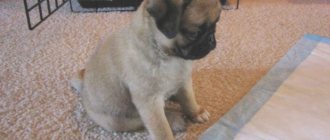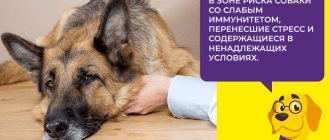Published: 3 months ago ⭐️⭐️⭐️⭐️⭐️
You can train a puppy from the first month, because a dog is not born smart. The simplest but most important commands are learned at this age. At this time, the character of the future dog is formed.
It is better to take up education from a very early age. Adult dogs are less trainable. It will be even more difficult to retrain it if the dog is used to behaving one way and not another.
It will take a little time to learn. Basically the puppy will run and play a lot. There is no need to be demanding and try to teach your puppy complex commands. He is still just a “child” and is more busy with pranks than with unquestioning obedience.
Take the Attention Test! Find 10 differences! (click right here!)
Find the answer Are you bothered by some problem or question? Enter “Breed” or “Name of the problem” into the form, press Enter and you will find out everything about the issue that interests you.
What to teach your dog in the first months
In the first 3 months, the baby must learn a lot. The very first and simplest thing is that he must respond to his nickname. To achieve this, you should call your four-legged dog by name as often as possible: during meals or to give a treat or toy. When the puppy comes running, you need to pet him and repeat his name several times. It’s good if all family members call the puppy. Then he will listen to his master and everyone at home.
Like every family member, the dog should have its own sleeping place in the house. It is important to arrange it in such a way that he likes it. It should be quiet and calm, cozy, away from drafts. When introducing your dog to its “nest” for the first time, you can put your favorite puppy toys and treats there. The dog must know where its place is and go there at the first request.
By the age of 3, the puppy should recognize and execute important commands:
- "ugh";
- "to me";
- "near";
- "fetch".
At first, all training sessions will take place in a relaxed manner, during games at home or on a walk. For example, the baby will become familiar with the “come to me” command if the owner wants to play with the puppy or give him something tasty. If the dog suddenly starts chewing furniture or biting, he will hear the command “fu”. You need to ensure that the puppy follows all commands the first time, without waiting for a second request. He will behave in this way in the future.
First acquaintance with the "fu" team
This is an important command. It will protect house shoes and things from dog teeth, and can solve problems with bad behavior of an inexperienced animal. In the future, a smart and obedient dog will no longer have to say “ugh” so often: it will already know well what is allowed to do and what is not.
The command “fu” must be pronounced with all severity. A menacing, piercing gaze into the dog's eyes will add the desired effect. The puppy will definitely sense dissatisfaction in the owner’s voice and feel guilty.
You cannot punish a puppy in the first 3 months. It is better to indicate your dissatisfaction with a threatening intonation. Sometimes you can spank him with your hand, but only on the butt. It is better not to use items for this. Having received a slipper in the back seat, the puppy may begin to take revenge on his offender, and all the slippers will be in danger. The dog is unlikely to get angry at the owner’s hand: among other things, it also feeds, caresses and plays.
If you punish your pet, then you need to do it during the “crime”, otherwise the puppy simply will not understand why he is being scolded.
How to properly limit the scope of what is permitted
Any crime entails punishment - the great Fyodor Mikhailovich wrote about this. However, when it comes to dogs, things are not so simple. Remember that animals have their own society, rules and orders, they perceive the world differently - many videos and films have been made about this. Our task is to teach them to distinguish between what is good and what is bad. The main thing is to avoid the verb “beat”, because there are many other ways of education.
Learning to prohibit correctly
Raising a puppy is impossible without prohibitions, but remember that you can only scold the baby while committing a crime. If you come home from work and everything in the apartment is upside down, it is useless to make a row and beat the puppy. He will associate punishment with your arrival, but not with a torn pillow.
Moreover, the punishment must always be adequate. You can only hit with a newspaper. Arm yourself with it and, at the moment of committing pranks, lightly slap the young prankster on the butt with the word “You can’t.” You can also clap your hands loudly and say a command in a stern voice.
Sometimes another method works with a baby. While he is enthusiastically sucking on the corner of the wallpaper, go up to him and lift him by the scruff of the neck, accompanying these actions with the command “No.” By the way, in the next video you will learn how to properly prevent a puppy from biting, and not hit him.
Rewards and punishments
Remember that you can’t just punish your puppy—be sure to praise those moments when he behaves correctly. Do not spare kind words; the dog does not understand their meaning, but very clearly catches the intonations in your voice. Remember that there should be much more kind words when raising a dog than negative ones. This is what many dog videos are about.
Don’t forget about tasty treats – they make raising a dog easier. Try to reward every correct action, especially during the first lessons, with a treat. It’s good if these are pieces of the food that the puppy loves most - cheese, dog biscuits or meat.
Unfortunately, many people believe that the key to successful training is the mandatory presence of punishments. But remember: you can’t hit the puppy! The most you can do is spank him with a newspaper.
Important: you should not hit the puppy with your hand - because of this, he may lose trust in you. Your hands should always be a source of praise and kindness for your dog, but never pain or misfortune.
Also, never use dog equipment - leashes, collars, etc. - as a means of punishment. The fact is that in this way you will only cause the baby to fear these objects, which can lead to problems both in training and in simple communication with the animal. There are many other ways to punish your dog.
Learning the command “come to me”
Hearing the command “come to me,” the pet must rush to this call with all its paws. The team will protect the puppy from many troubles that await him on the street. The baby will not run away to a dangerous distance, will not get hit by a car, or run into adult and aggressive dogs. To make the puppy run to the call with pleasure, you can interest the baby with a treat or toy. The main thing is that the approach should evoke positive associations in the puppy.
When the dog is unable to follow a command, a long leash-roulette will come to the rescue. You need to say “to me” again and pull the pet in your direction. Another trick: when the puppy does not respond to the call, you can run away from him. He will get scared and run after you. At this time, it will be useful to comment on his action several times with the command “come to me.”
If the dog is interested in something, and everything indicates that it will not fit, it is better not to give the command. Training should take place in calm and comfortable conditions. If the training lasts a long time, it may be that the puppy is simply tired and needs a break.
How to teach your pet to run next to you
In the first months of growing up, you should not demand from him strict execution of the command “nearby”. It is unlikely that the puppy will be able to go toe-to-toe with the owner. He will regularly run off in his own direction, pulling on the leash. From the age of 3 months, the baby must be taught to fulfill this request.
At the beginning of training, you will need a strict collar with links in the form of spikes. It is important to wean your dog from pulling on the leash. On the command “near”, the puppy must run strictly next to the owner’s left leg, not lag behind and not run ahead.
In order for your puppy to quickly learn this, you need to:
- Stop and start moving more often;
- Turn and make U-turns;
- Speed up and slow down.
A command must be given every time there is a change in movement. If the puppy goes as it should, you must remember to praise him, and if he does not follow the command or is confused, guide him with a leash. The hardest part will be making a U-turn. The main thing: the movements should be smooth so that the baby has time to readjust.
We teach the command “Fetch, baby”
The “fetch” command is not pampering at all. Thanks to her, the puppy will develop energetic and physically healthy. Having splashed out all the energy on a walk, the baby will be calm and obedient at home.
This command is fully trained from the age of five months. But it is necessary to introduce a four-legged baby to it much earlier. For now, this command will be practiced in a playful manner and will not be strictly observed.
The main condition without which no dog will become active in this process is the owner’s genuine interest in the game. Children cope better with this task.
If the dog does not express a desire to run after the thrown object, you can “revive” it. If it's a stick, kick it with your feet. Surely this will interest the puppy. When he grabs it in his teeth, you can fight with the baby, taking away his prey. As a result, the process will turn into an exciting game. All you have to do is remember to say “fetch” from time to time.
Methods for properly training a puppy in practice are not so difficult. The main thing is that it brings pleasure to both the puppy and its owner. Then there is every chance that the little fool will soon turn into an adult, smart and well-mannered dog and become a source of pride.
How to train a dog by saying “No” correctly
When you are looking for ways and methods on how to raise a dog, you cannot do without such an important word as “no” in the process of training it. It is important that you learn how to say it to your dog correctly. You can replace the word “no” with something else that you will use only at the moment when the dog has done something bad, or when you want to warn him about what he is going to do.
When you want to warn your dog, stand next to him, touch his neck (gently) and say “no” in a firm voice but in a non-aggressive manner.
When to start training
Training is intertwined with education with a thin thread. You need to start this from the very first days it appeared in your home.
Opinions often differ. Some say no earlier than six months, others suggest starting at one year of age. 1 year of a dog is equivalent to 7 years of a human.
Imagine that the child is not limited in anything, he is allowed everything and is not taught anything until he is 3.5 or even 7 years old. Will it be easy to catch up later? We repeat: take care of the puppy from the first days of his arrival in your home.
If you don’t set your own rules, the dog will try to set them himself, and this is fraught with big conflicts with the owners.
Avoid physical punishment when raising your dog
Research shows that physical punishment of dogs results in more aggressive animals. Try to refrain from hitting or physically harming your pet. Such actions can undermine both the dog's health and the trust between you, which will lead to additional problems in raising your dog.
Author of the article : Ilya Samokhvalov, “Moscow Medicine”© Disclaimer : The information presented in this article on how to raise a dog is intended for informational purposes only.
How to train a husky
The Siberian Husky is a smart breed. These are confident, balanced dogs with nerves of steel. Huskies are completely unsuitable for protection; they have always acted as sled dogs in distant Siberia.
If you are an active person who loves to travel and spends a lot of time outdoors, this is the breed for you. Huskies are easy to train, but they are leaders by nature and can show their own character.
If you choose to have your dog trained by a professional, remember that you will have to train him too. Due to their good endurance, huskies can be trained in any weather conditions; take time for long walks in the fresh air and morning jogging.
How to raise a dog with the help of friends
Your friends may not know how to raise a dog correctly. However, they are quite capable of helping you in this difficult matter. With the help of your friends, you can teach your dog to enjoy the company of other people, not be afraid of them, and at the same time not be aggressive towards them.
Invite your friends to play with your dog or let them boss him around for a while. Let your friends command your dog to “Sit!” or “Lie down!” All this will teach your dog to respond normally to other people and enjoy their company.
Labrador training
The Labrador is a companion dog and is suitable for families with children. In order for you to have a wonderful friend, you need to have basic knowledge of how to train a Labrador. The puppy can be taught all the necessary commands at home.
Dogs of this breed completely trust a person, they do not expect nasty things from the trainer, so they can train for a long time and with great pleasure. They love human interaction, so they will happily accept a stroke or a kind word as praise instead of a treat.
The Labrador is a peace-loving dog; it will be less distracted during training with other animals, unlike fighting breeds. These dogs have a temperament - they cannot be called lethargic, but they are not impulsive, moderately active, with healthy motor activity - just what is necessary for successful training.
How to raise a loyal and reliable friend from a naughty puppy?
If a puppy has settled in the house, then you now have to teach him everything necessary that an adult dog should be able to do. It doesn’t matter at all whether it’s a purebred or a mongrel. You've probably already read a huge number of articles where you learned the basics of raising puppies for dummies. But it happens that the baby came to you completely by accident, and you have no experience in keeping a dog. So how to properly raise a puppy?
Dog owner experience
From personal experience: you should not start training if you are in a bad mood, dogs are excellent psychologists, and your depression can rub off on them. Both puppies and adults copy their owner in everything; a loving dog will try to be with you always and everywhere.
Dogs are also manipulators - they are capable of finding a special approach to everyone in order to satisfy their whims. In general, there are no two identical puppies or adult dogs, each of them has its own character and different habits. Something is inherent in nature, and something is acquired during life.
How you train your puppy will to some extent determine its future character. It depends only on you whether your pet will grow up to be a cheerful and devoted friend or a nervous, unsociable creature.
How to train a dog without raising your voice at him
It is very important for the owner to know how to raise a dog without shouting during its training. You should speak to your pet sternly and assertively, showing your leadership. At the same time, you should never yell at your dog. Your screams will only make your dog afraid of you and not do what you ask of him.











